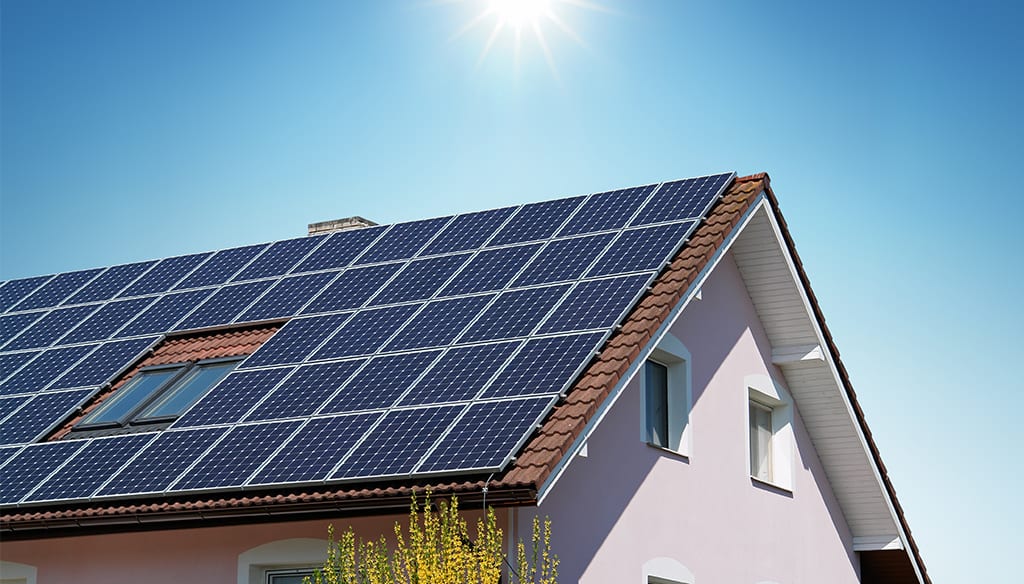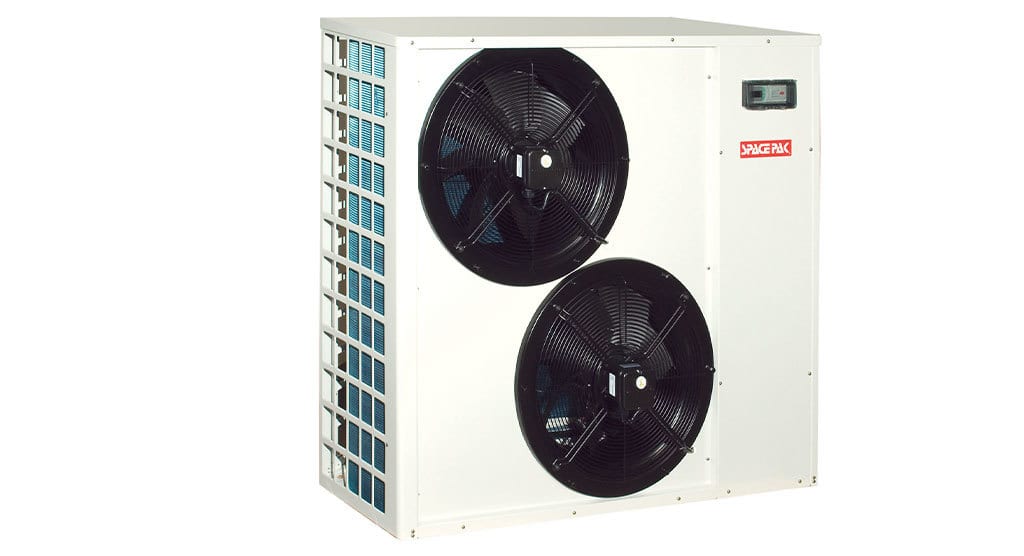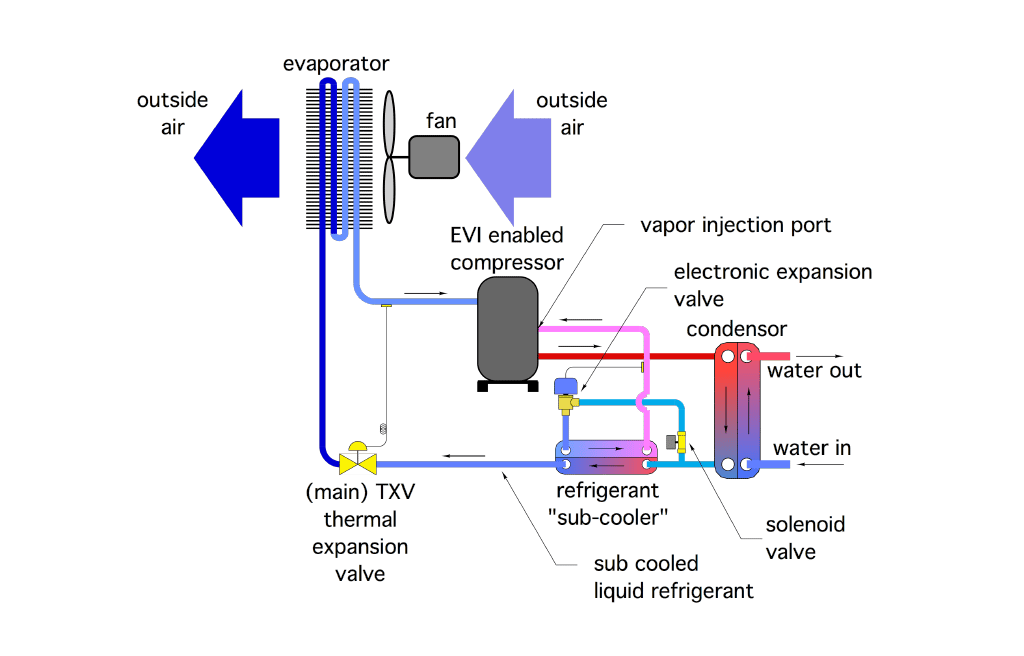Cold climate air-to-water heat pumps
Electrically powered heat pumps, in many varieties, are destined to play an increasing important role in heating and cooling buildings around the world.

Electrically powered heat pumps, in many varieties, are destined to play an increasingly important role in heating and cooling buildings around the world.
Heat pumps capture low-grade heat from solar-resupplied sources such as outside air and soil several feet below the earth’s surface. They convert vast amounts of otherwise unusable low-temperature heat into heat at sufficient temperatures to warm buildings or heat domestic water.
Electrically powered heat pumps dovetail nicely with large-scale renewable sources of electrical energy such as utility-scale photovoltaic systems, large wind turbine farms or CHP systems operating on biogases produced from agricultural and municipal waste.
Not what they used to be
The classic heat pump for residential heating and cooling debuted in North America during the 1970s. Big-name HVAC companies such as Carrier, York, Lennox and Trane developed markets for these early generation “air-to-air” heat pumps. These systems consisted of two major subassemblies; an outdoor condenser unit and an indoor air handler. These subassemblies were connected by refrigeration tubing and wiring.
Although air-to-air heat pumps have been around for several decades, early generation units were not able to maintain reasonable efficiency and heating capacity at low outdoor air temperatures. It was not uncommon to turn off an early generation air-to-air heat pump when outdoor temperatures dropped below 15° to 20° F. At that condition, an auxiliary heat source, such as a furnace or electric strip heating elements within the indoor air handler, was turned on to supplement or completely take over the building’s heating load.
The significant drop in performance at low ambient temperatures limited use of early generation air-to-air heat pumps in cold climates. However, advances in refrigeration technology, including inverter drive variable-speed compressors and a process known as enhanced vapor injection (EVI) now allow air-source heat pumps to operate at very low outdoor temperatures, typically down to minus 13° (minus 25° C).
Some of the largest global providers of heating and cooling hardware, including Mitsubishi, Fujitsu, Toshiba, Daikin, LG and Panasonic, now offer “cold climate” versions of air-to-air heat pumps. The most common configuration is called a ductless mini-split heat pump system. A single outdoor unit connects to multiple indoor wall-mounted cassettes, each supplied by its own refrigeration line set. Each indoor unit operates independently, allowing for zoning.
Although cold climate ductless mini-split heat pumps have carved out a nice market share over the last decade, they still rely on forced-air delivery of heating and cooling. As such they don’t offer the potential to combine their high thermal efficiencies with the unsurpassed comfort provided by a well-designed hydronic distribution system. Furthermore, most ductless mini-split heat pump systems can only provide space heating and cooling. Most lack the ability to supply ancillary loads such as domestic water heating or pool/spa heating.
Water trumps air
This is where a different heat pump configuration becomes attractive. An air-to-water heat pump uses the same concept as an air-to-air heat pump for extracting low-temperature heat from outdoor air. The difference is it delivers heat at useful temperatures into a stream of water (rather than air) passing through its condenser.
Some air-to-water heat pumps, such as the unit shown in Figure 1, are capable of producing leaving water temperatures of more than 130º even with relatively cold outdoor air. This sets the table for use of hydronic heat emitters such as radiant floors, radiant walls and radiant ceiling panels, panel radiators, fan-coil convectors and even contemporary low-temperature fin-tube baseboard. It also allows the heat pump system to be configured to provide most, if not all the energy needed for domestic water heating. With a suitable heat exchanger, heated water from an air-to-water heat pump also can be used to heat a swimming pool or maintain the water temperature in a spa.

ENLARGE
FIGURE 1
Although most North American heating professionals are familiar with ductless mini-split heat pumps as well as geothermal heat pumps, few are currently familiar with air-to-water heat pumps.
This is not the case in Asia and Europe. According to the August 2015 issue of the Japanese publication JARN, the 2014 global market for air-to-water heat pumps totaled more than 1.7 million units! The Chinese market alone represented almost 1 million units sold in 2014. The European market was at 232,000 units, with France as the top market followed by Germany and the United Kingdom. Many of these air-to-water heat pumps were produced by the same Asian-based firms that sell ductless mini-split heat pumps in North America. Others came from European-based companies, including Viessmann, Bosch, Vaillant, Dimplex and Wolf. The U.S. market was a tiny fraction of global sales.
Why such a difference? One likely reason is the relatively small market for residential hydronics in the U.S. and Canada compared to Asian and European markets. Another is the very limited use of chilled water cooling in smaller North American buildings. Manufacturers also have to consider the cost of supporting a new product line in a market (such as North America) that requires a lot of hand-holding before the installations become routine.
“The typical net-zero house has a very low-loss thermal envelope and a sizable solar photovoltaic array on the roof. Net metering laws — where they exist — allow owners of photovoltaic systems to sell surplus electrical power back to the utility at full retail rate.”
Looking ahead
This is not to suggest that a strong future market for air-to-water heat pumps can’t develop in North America. Several trends suggest just the opposite. Here are some key indicators:
1. Growing interest in net-zero houses: The typical net-zero house has a very low-loss thermal envelope and a sizable solar photovoltaic array on the roof. Net metering laws — where they exist — allow owners of photovoltaic systems to sell surplus electrical power back to the utility at full retail rate. Thus, surplus kilowatt-hours produced on a sunny summer day could conceivably be “parked” on the electrical grid and reclaimed to run a heat pump on a cold winter night with no technical or economic penalty. That’s a pretty sweet deal!
One common approach to heating and cooling net-zero homes is to install two or three high-wall cassettes (e.g., the indoor portion of a ductless mini-split heat-pump system) in central areas and leave interior doors open for distribution of the heated or cooled air. Proponents of this approach stress their belief that no interior comfort distribution system, such as ducting or piping, is needed.
One online discussion of this topic states if all interior doors are left open, interior air temperatures will stabilize at not less than 2° below the air temperature where the indoor cassette is located. This discussion also points out if bedroom doors are closed at night — a reasonable expectation — bedroom temperature may drop 5° below the temperature where the heat pump indoor unit is located.
Should these constraints be accepted without reservation? I say absolutely not!
There’s a difference between simply putting heat back into a space to match the rate of heat loss and doing so in a way that provides excellent thermal comfort. There also are reasons why builders put doors on interior rooms and it’s not for achieving 5° automatic temperature setbacks when they are closed. In my opinion, these constraints represent significant “negatives” for the ductless mini-split approach in a net-zero house.
The alternative I suggest is to retain the thermal efficiency of the low ambient air-source heat pump, but switch to hydronics for the balance of system. This is a well-understood practice in Europe and Asia, and it stands ready to gain acceptance in North America.
Use a low-temperature hydronic delivery system such as a heated ceiling or floor to allow good performance from the heat pump and proper distribution of heat throughout the building, doors open or closed. There’s no reason comfort should be compromised to accommodate the idiosyncrasies of the heating system.
Cooling can be handled using chilled water flowing through a central air handler, or multiple small air handlers, some of which look and operate almost identically to the high-wall cassettes used with ductless mini-split heat pumps.
All chilled water air handlers must be equipped with condensate drip pans and suitable drains. Cooling also can be done using radiant panels in combination with a single, small air handler. The radiant panel can handle most, if not all, of the sensible cooling load. It must operate at chilled-water temperatures that remain of the room’s depot at all times. This can be handled with mixing controls. A single small air handler also would be required to provide moisture removal. The use of water-based radiant cooling can significantly decrease the “distribution energy” required relative to all-air systems.
2. The 30% federal tax credits on geothermal heat pump systems are scheduled to end as of Dec. 31: This will remove a significant purchasing incentive and force geothermal heat pump systems to compete against other types of heat pumps in an unsubsidized market.
3. Air-to-water heat pumps are significantly less expensive to install compared to geothermal heat pumps: This is especially true if vertical boreholes are required for the earth loop. In my area, these holes cost more than $3,000 per ton for drilling, pipe insertion and grouting. Additional cost is incurred for connecting multiple vertical piping loops and routing piping back to the location of the heat pump. Replacement of any affected pavements or landscaping also needs to be factored into the cost of installing a geothermal heat pump system.
4. Low ambient air-to-water heat pumps are available: Some air-to-water heat pumps now are available that can operate at ambient air temperatures down to minus 13°. One unit currently on the U.S. market lists a heating capacity of 47,500 Btu/hr., and a coefficient of performance of 2.55 at 0° outdoor temperature with 120° water temperature leaving its condenser. The COP rises to 2.75 when the outdoor air temperature is 20°.
The improved low ambient performance is achieved through a modified vapor/compression refrigeration system known as enhanced vapor injection. In heating mode operation, some of the liquid refrigerant leaving the condenser is sent through an electronically controlled expansion valve and then into a “sub-cooler” heat exchanger as shown in Figure 2.

ENLARGE
FIGURE 2
This refrigerant evaporates within the sub-cooler absorbing heat from the remainder of the liquid refrigerant stream. This further reduces the temperature of the liquid refrigerant before it passes through the main thermal expansion valve. The vaporized refrigerant leaving the sub-cooler passes into a special medium pressure port on the scroll compressor and is captured within the scroll set, effectively increasing refrigerant mass flow rate. This modified vapor/compression refrigeration system allows the “low ambient” air-to-water heat pump to be applied in northern locations that have traditionally been viewed as “too cold” for air-source heat pumps.
5. Diminishing returns: As home heating loads become smaller due to better thermal envelopes, the difference in annual heating cost between heat pumps operating at seasonal average COPs that vary by perhaps 1.0 or less, decreases. The incrementally lower operating cost of the higher performance heat pump may not be able to amortize the higher installation cost within the expected life of the system.
For example: A home with a design heat loss of 25,000 Btu/h, based on an outdoor temperature of 0° and indoor temperature of 70° and located in a 7000 (° F•day), would have an estimated annual heating requirement of about 39 MMBtu/year. If this load were supplied using a geothermal heat pump with a seasonal average COP of 3.3 (which includes the power required to operate the earth loop circulators) in a location where electrical energy is priced at $0.12/kWh, the annual heating cost would be about $416.
If the same 39 MMBtu/year were supplied from a low ambient air-to-water heat pump with a seasonal average COP of 2.7, the annual heating cost would be about $508. The difference in operating cost, $92/year, would not be able to amortize what easily could be a (after-tax credit) $7,000-$9,000 higher installation cost within the life of the equipment. This situation obviously gets worse for the geothermal heat pump when/if the 30% federal tax credits expire at the end of this year.
6. As home space heating loads get smaller, the domestic water heating load becomes an increasingly higher percentage of the total annual heating energy requirement. Some estimates put the DHW load at 25-30% of the total annual energy requirement in a well-insulated modern home.
Most ductless mini-split heat pumps cannot provide domestic water heating, but a properly configured air-to-water heat pump can.
A standard electric water heater providing domestic water heating in a situation where the heat pump cannot, delivers heat at a COP of 1.0. If that energy was instead attained through an air-to-water heat pump, it could be delivered at a COP averaging perhaps 2.5 over the year. For a family of four needing 60 gal./day of water heated from 50° to 120°, and assuming electrical energy priced at $0.12 per kWh/h, the difference in annual domestic water heating cost between these scenarios is $270. That is roughly three times more than the annual savings associated with using a geothermal heat pump vs. the air-to-water heat pump in the previous example.
We’ve discussed the market rationale behind air-to-water heat pumps. In part two, we’ll look at piping concepts for low ambient air-to-water heat pumps. You’ll see it’s relatively easy to build modern hydronic systems that can take advantage of these heating and cooling sources and do so without compromising comfort.
narvikk/E+ via Getty Images. Figure 1 courtesy of Spacepak. Figure 2 courtesy of John Siegenthaler.
This article was originally published in PM Engineer in June 2016.